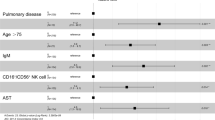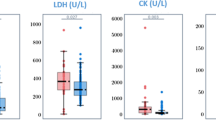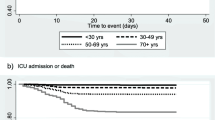Abstract
The objective of the study is to develop a method that enables to predict disease severity at the moment of admission to an intensive care unit and to choose appropriate respiratory support. The problem of patient classification by disease course is solved by using information about comorbid chronic states and a modified comorbidity index. To prove the applicability of the index for severe COVID-19 patients, we developed a mathematical model for disease progression. The estimated values of the model parameters showed the difference between probabilities of transition to critical states and/or lethal outcome in different groups.





Similar content being viewed by others
REFERENCES
J. Hua, C. Qian, Z. Luo et al., “Invasive mechanical ventilation in COVID-19 patient management: the experience with 469 patients in Wuhan,” Crit. Care 24 (1), 348 (2020). https://doi.org/10.1186/s13054-020-03044-9
L. S. Menga, C. Berardi, E. Ruggiero et al., “Noninvasive respiratory support for acute respiratory failure due to COVID-19,” Curr. Opin. Crit. Care 28 (1), 25–50 (2022). https://doi.org/10.1097/mcc.0000000000000902
M. Antonelli, G. Conti, M. L. Moro et al., “Predictors of failure of noninvasive positive pressure ventilation in patients with acute hypoxemic respiratory failure: a multi-center study,” Intensive Care Med. 27 (11), 1718–1728 (2001). https://doi.org/10.1007/s00134-001-1114-4
S. Baker, W. Xiang, and I. Atkinson, “Continuous and automatic mortality risk prediction using vital signs in the intensive care unit: a hybrid neural network approach,” Sci. Rep. 10, 21282 (2020). https://doi.org/10.1038/s41598-020-78184-7
P.J.H. Hulshof, N. Kortbeek, R.J.Boucherie et al., “Taxonomic classification of planning decisions in health care: a structured review of the state of the art in OR/MS,” Health Syst. 1, 129–175 (2012). https://doi.org/10.1057/hs.2012.18
I. M. Longini Jr., W. S. Clark, R. H. Byers et al., “Statistical analysis of the stages of HIV infection using a Markov model,” Stat. Med. 8, 831–843 (1989). https://doi.org/10.1002/sim.4780080708
A. Moran, D. Gu, D. Zhao et al., “Future cardiovascular disease in China: Markov model and risk factor scenario projections from the coronary heart disease policy model–China,” Circ.: Cardiovasc. Qual. Outcomes 3, 243–252 (2010). https://doi.org/10.1161/circoutcomes.109.910711
M. S. Rangel Frausto, D. Pittet, T. Hwang et al., “The dynamics of disease progression in sepsis: Markov modeling describing the natural history and the likely impact of effective antisepsis agents,” Clin. Infect. Dis. 27, 185–190 (1998). https://doi.org/10.1086/514630
L. Peelen, N. F. de Keizer, E. de Jonge et al., “Using hierarchical dynamic Bayesian networks to investigate dynamics of organ failure in patients in the Intensive Care Unit,” J. Biomed. Inf. 43, 273–286 (2010). https://doi.org/10.1016/j.jbi.2009.10.002
C. A. King, H. Englander, P. T. Korthuis et al., “Designing and validating a Markov model for hospital-based addiction consult service impact on 12-month drug and non-drug related mortality,” PloS One 16, e0256793 (2021). https://doi.org/10.1371/journal.pone.0256793
D. Yu. Belousov, E. V. Afanasyeva, A. S. Beketov, and Yu. B. Belousov, “Prediction of the impact of statins on direct medical costs in secondary prevention for patients at high risk of developing cardiovascular diseases,” Kach. Klin. Prak., No. 1, 97–115 (2011).
N. D. Yushchuk, O. O. Znoiko, N. A. Yakushechkina et al., “The burden of viral hepatitides in the Russian Federation and ways of its reduction for the long term (in case of hepatitis C),” Ter. Arkh. 85 (12), 79–85 (2013).
A. V. Rudakova, S. M. Kharit, L. V. Lyalina et al., “Cost-effectiveness of quadrivalent human papillomavirus vaccination in adolescent girls in the Russian Federation,” Pediatr. Farmakol. 14, 494–500 (2017). https://doi.org/10.15690/pf.v14i6.1832
D. Hazard, K. Kaier, M. von Cube et al., “Joint analysis of duration of ventilation, length of intensive care, and mortality of COVID-19 patients: a multistate approach,” BMC Med, Res. Methodol. 20, 206 (2020). https://doi.org/10.1186/s12874-020-01082-z
V. Ya. Kiselevskaya-Babinina, K. A. Popugaev, V. A. Molodov, and I. V. Kiselevskaya-Babinina, “Utilization of infectious bed resources during the Covid-19 epidemic depending on patient characteristics,” Neotlozhnaya Med. Pomoshch 12 (3) (2023) (in press).
M. E. Charlson, P. Pompei, K. L. Ales, and C. R. MacKenzie, “A new method of classifying prognostic comorbidity in longitudinal studies: development and validation,” J. Chronic Dis. 40, 373–383 (1987). https://doi.org/10.1016/0021-9681(87)90171-8
W. D’Hoore, C. Sicotte, and C. Tilquin, “Risk adjustment in outcome assessment: The Charlson comorbidity index,” Methods Inf. Med. 32, 382–387 (1993). https://doi.org/10.1055/s-0038-1634956
M. Charlson, M. T. Wells, R.Ullman et al., “The Charlson comorbidity index can be used prospectively to identify patients who will incur high future costs,” PloS One 9, e112479 (2014). https://doi.org/10.1371/journal.pone.0112479
A. V. Molochkov, D. E. Karateev, E. Yu. Ogneva et al., “Comorbidities and predicting the outcome of COVID-19: the treatment results of 13,585 patients hospitalized in the Moscow Region,” Alm. Klin. Med. 48 (1), S1–S10 (2020). https://doi.org/10.18786/2072-0505-2020-48-040
X. Wang, X. Fang, Z. Cai et al., “Comorbid chronic diseases and acute organ injuries are strongly correlated with disease severity and mortality among COVID-19 patients: A systemic review and meta-analysis,” Research 2020, 2402961 (2020). https://doi.org/10.34133/2020/2402961
L. Liu, J. Xie, W. Wu et al., “A simple nomogram for predicting failure of non-invasive respiratory strategies in adults with COVID-19: a retrospective multicentre study,” Lancet Digital Health, 3, e166-e174 (2021). https://doi.org/10.1016/S2589-7500(20)30316-2
Yu. Suhov and M. Kelbert, Markov Chains: A Primer in Random Processes and Their Applications (Cambridge Univ. Press, Cambridge, 2008; MCCME, Moscow, 2010).
A. Agresti, Categorical Data Analysis (Wiley, New York, 2003).
B. Ripley and W. Venables, Package ‘nnet’, R Package Version 7.3-12 (2016). URL: https://cran.r-hub.io/web/packages/nnet/index.html
W. N. Venables and B. D. Ripley, Modern Applied Statistics with S, 4th ed. (Springer, New York, 2002). https://doi.org/10.1007/978-0-387-21706-2
B. Efron and R. J. Tibshirani, An Introduction to the Bootstrap (Chapman and Hall/CRC, New York, 1994). https://doi.org/10.1201/9780429246593
B. Hu, H. Guo, P. Zhou, and Z.-L. Shi, “Characteristics of SARS-CoV-2 and COVID-19,” Nat. Rev. Microbiol. 19, 141–154 (2021). https://doi.org/10.1038/s41579-020-00459-7
A. E. Ivanova, N. B. Pavlov, and A. Yu. Mikhailov, “Trends and regional peculiarities of adult health in Russia,” Sots. Aspekty Zdorov’ya Naseleniya, No. 3 (19), 25 (2011).
V. Yu. Semenov, “The morbidity of population of the Russian Federation: Geographic characteristics,” Probl. Sots. Gig., Zdravookhr. Istor. Med. 23 (6), 6–9 (2015).
A. K. Singh, A. Singh, R. Singh, and A. Misra, “Molnupiravir in COVID-19: A systematic review of literature,” Diabetes Metab. Syndr.: Clin. Res. Rev. 15, 102329 (2021). https://doi.org/10.1016/j.dsx.2021.102329
G. Fink, N. Orlova-Fink, T. Schindler et al., “Inactivated trivalent influenza vaccination is associated with lower mortality among patients with COVID-19 in Brazil,” BMJ Evid.-Based Med. 26, 192–193 (2021) . https://doi.org/10.1136/bmjebm-2020-111549
Funding
This study was financially supported by the Russian Ministry of Education and Science through grant no. 075-11-2020-011 (13.1902.21.0040).
Author information
Authors and Affiliations
Corresponding authors
Ethics declarations
The authors declare that they have no conflicts of interest.
APPENDIX
APPENDIX
Values of Model Parameter Estimations and Their Confidence Intervals
Rights and permissions
About this article
Cite this article
Kisselevskaya-Babinina, V.Y., Romanyukha, A.A. & Sannikova, T.E. Mathematical Model of COVID-19 Progression: Prediction of Severity and Outcome. Math Models Comput Simul 15, 987–998 (2023). https://doi.org/10.1134/S2070048223060121
Received:
Revised:
Accepted:
Published:
Issue Date:
DOI: https://doi.org/10.1134/S2070048223060121




